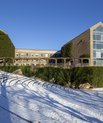Changes in long-term financial outlook for Arts
The DKK 29 million surplus for 2017 at the Faculty of Arts has given Dean Johnny Laursen reasons to believe that there is less need to ‘cry wolf’.

Dear staff,
Since the beginning of 2015, the faculty management team at Arts has been working intensively to prepare the faculty for the expected financial challenges in the coming years as a result of degree programme resizing, the study progress reform and the reallocation contribution.
We have – not least due to your efforts – made great progress in terms of reducing costs, and we are now confident that if we maintain our efforts and stick to our decisions, we dare to believe in a brighter long-term outlook.
Following the experience gained from the degree programme resizing and the study progress reform, as well as the reasonable funding reform, we can now look further ahead. It is important to underline that there are no guarantees. However, at the moment we believe that due to the considerable increase in the financial – and academic – performance of the faculty, we are prepared to face the significant losses of revenue in the next few years before reaching a level of stability once the degree programme resizing has been fully implemented. This is apparent from the significant one-time investments we have been able to make and the considerable surpluses we have achieved – DKK 29 million in 2017. We need to achieve a surplus – after further losses of revenue – to reach a break-even point in the coming years. Therefore, we can look to the near future with confidence.
This has not come about by itself; it is the fruit of due diligence and collaboration – also with the students. Administrative cutbacks have been carried out, costs for facilities have been reduced, and difficult decisions have been made with regard to study progress and adapting to the reduced student population. Finally, the faculty has achieved an impressive increase in external research funding, which bears witness to the ability to continue the scientific development despite the tough conditions when it comes to education.
If the outlook is to remain bright, we need to maintain the high level of performance at Arts in recent years. If we succeed, we anticipate that we do not have to take further measures to reduce costs and increase efficiency, in addition to the measures already taken and planned.
In 2015, we estimated that – by natural wastage – a gradual decrease in the number of permanent academic staff of around 60 positions was necessary up to 2023. In the light of the faculty’s improved financial standing within the last few years and greater certainty that our decisions have a positive effect, I have already informed that this estimation was probably too pessimistic. We now anticipate that the number of permanent academic staff will be reduced by no more than 20. This is a radical change of expectations and, of course, a somewhat more positive outlook. For that reason, I also believe that there is less need to ‘cry wolf’.
This means that the faculty can continue to employ academic staff, perhaps even to a greater extent than previously expected. It also means that we can continue to advertise more professorships as well as maintaining a high number of PhD students, which is a valuable asset. The most important thing is that after years of adapting to a dramatic reduction in the number of students, we will have more resources to focus on academic development and the development of the faculty in the years ahead.
Johnny Laursen

